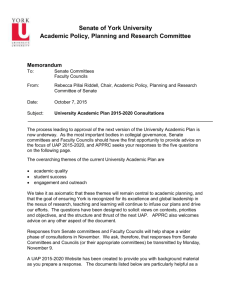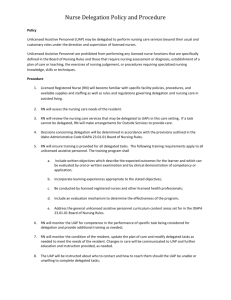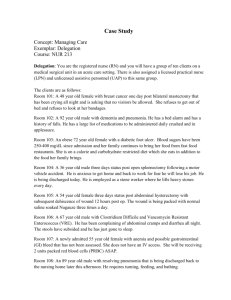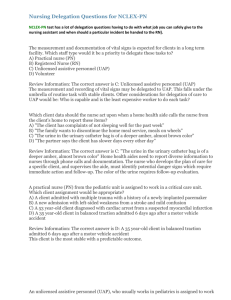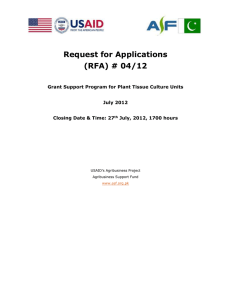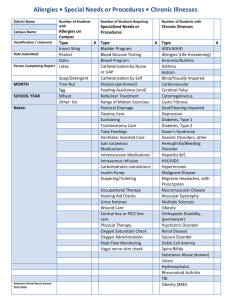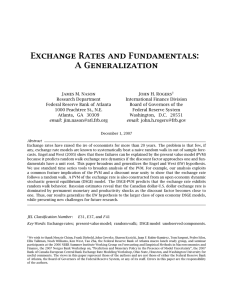Impact on combined uncertainty brought about by changes in
advertisement
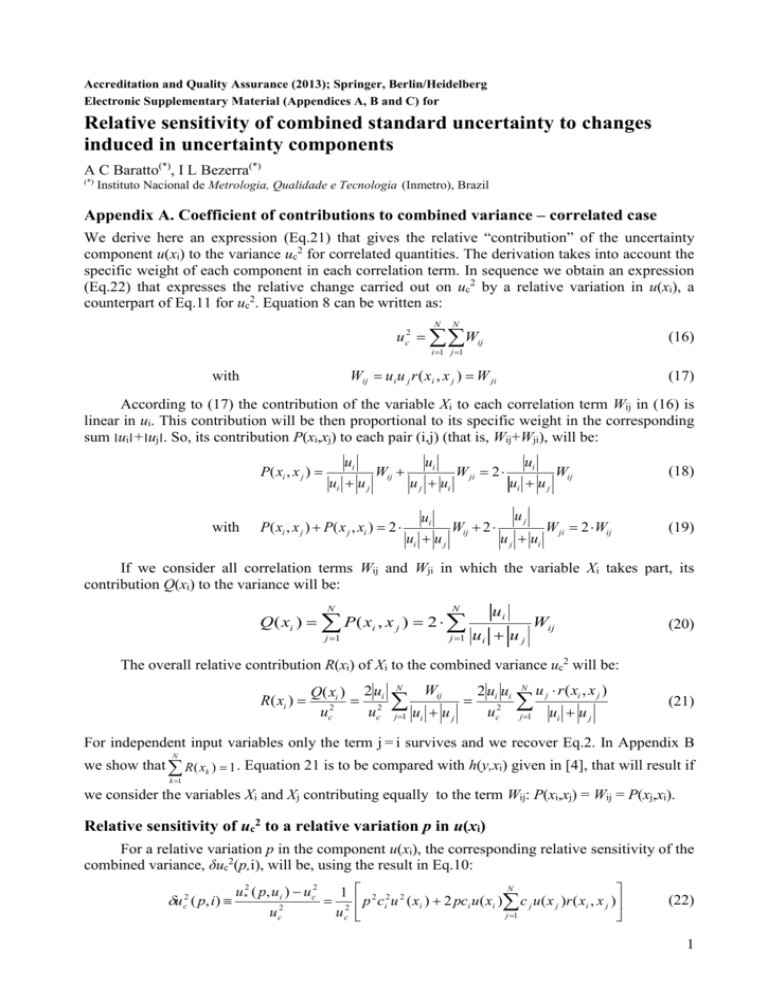
Accreditation and Quality Assurance (2013); Springer, Berlin/Heidelberg Electronic Supplementary Material (Appendices A, B and C) for Relative sensitivity of combined standard uncertainty to changes induced in uncertainty components A C Baratto(*), I L Bezerra(*) (*) Instituto Nacional de Metrologia, Qualidade e Tecnologia (Inmetro), Brazil Appendix A. Coefficient of contributions to combined variance – correlated case We derive here an expression (Eq.21) that gives the relative “contribution” of the uncertainty component u(xi) to the variance uc2 for correlated quantities. The derivation takes into account the specific weight of each component in each correlation term. In sequence we obtain an expression (Eq.22) that expresses the relative change carried out on uc2 by a relative variation in u(xi), a counterpart of Eq.11 for uc2. Equation 8 can be written as: N N u c2 Wij (16) i 1 j 1 Wij u i u j r ( xi , x j ) W ji with (17) According to (17) the contribution of the variable Xi to each correlation term Wij in (16) is linear in ui. This contribution will be then proportional to its specific weight in the corresponding sum ׀ui׀+׀uj׀. So, its contribution P(xi,xj) to each pair (i,j) (that is, Wij+Wji), will be: P( xi , x j ) with ui ui u j ui Wij P( xi , x j ) P( x j , xi ) 2 W ji 2 u j ui ui ui u j Wij 2 ui ui u j uj u j ui Wij W ji 2 Wij (18) (19) If we consider all correlation terms Wij and Wji in which the variable Xi takes part, its contribution Q(xi) to the variance will be: N N ui j 1 j 1 ui u j Q ( xi ) P ( xi , x j ) 2 Wij (20) The overall relative contribution R(xi) of Xi to the combined variance uc2 will be: R( xi ) Q( xi ) 2 ui 2 uc2 uc N u j 1 i Wij uj 2 ui ui uc2 N u j r ( xi , x j ) j 1 ui u j (21) For independent input variables only the term j = i survives and we recover Eq.2. In Appendix B N we show that R ( xk ) 1 . Equation 21 is to be compared with h(y,xi) given in [4], that will result if k 1 we consider the variables Xi and Xj contributing equally to the term Wij: P(xi,xj) = Wij = P(xj,xi). Relative sensitivity of uc2 to a relative variation p in u(xi) For a relative variation p in the component u(xi), the corresponding relative sensitivity of the combined variance, δuc2(p,i), will be, using the result in Eq.10: u c2 ( p, i) u*2 ( p, u i ) u c2 1 2 2 uc uc N 2 2 2 p c u ( x ) 2 pc u ( x ) i i i i c j u ( x j )r ( xi , x j ) j 1 (22) 1 This equation is to be compared with Eq.11. We get the integral relative sensitivity of uc2 to u(xi) making p = –1: u c2 (1, i) N 1 2 2 c u ( x ) 2 c u ( x ) c u ( x ) r ( x , x ) i i i i j j i j u c2 j 1 (23) From (22), for independent input variables: u c2 ( p, i) ind ci2 u 2 ( xi ) 1 2 2 2 2 2 p c u ( x ) 2 pc u ( x ) p ( p 2 ) i i i i u c2 u c2 (24) For independent input variables and p = –1, identically as for Eq.21 and except for the minus sign (expressing the decrease in the uc2 value), we have Eq.2 again. u (1, i)ind 2 c ci2u 2 ( xi ) ui2 2 R( xi ) uc2 uc (25) Equations 23 and 25 may alternatively be interpreted as the relative variation that occur in uc2 when the component u(xi) is disregarded in the calculation, the other components remained constant, or (taking the absolute value) as the fraction of the combined variance that survives when all components except u(xi) are disregarded (the interpretation implicitly used in [4]). Expressed in terms of the parameters u(xi) and r(xi,xj), equations 22 and 23 are more readily interpreted than are Eq.11 in [4], expressed in terms of u(xi,xj). Furthermore, Eq.23 above and Eq.11 of [4], although slightly different, can both be used for expressing the integral relative sensitivity of uc2 to a component. Our approach is equivalent to that of [4], with the difference that it takes into account the relative weights of the components in each term Wij. But this is an academic discussion. Comparing Eq.22 with Eq.11 we may write a general simple relation between the relative sensitivities of uc and uc2: uc ( p, i) 1 uc2 ( p, i) 1 (26) N Appendix B. Demonstration that R( x ) 1 i i 1 N N R( x ) 1 Q( x ) u i 1 N N N N i 1 i 1 i 1 j 1 Q( xi ) P( xi , x j ) ( = (2 ( ( u1 u1 u1 u2 u 2 u1 u3 u 3 u1 W11 ) ( W21 W31 u1 u1 u 2 u2 u1 u 2 u3 u1 u 3 ui u j W12 ) (2 W13 ) ... ( Wij j 1 u1 u 2 u1 u2 u2 u2 uk u k u1 i i 1 N ui W12 i ui u j ui W21 ) ( W22 ) ( Wk1 2 c W ji ) u1 u1 u3 u2 u 2 u3 uk u1 u k W13 W23 u1 u3 u1 W31 ) ... u2 u3 u 2 W1k ) ... (2 W32 ) ... uN uN uN WNN ) (Rearranging the terms:) 2 W11 ( u1 u2 u u2 u u3 u u3 u uN u uN W12 1 W21 ) ( 1 W13 1 W31 ) ... ( 1 W1N 1 WN 1 ) u1 u2 u2 u1 u1 u3 u3 u1 u1 u N u N u1 ... W22 ... ( uk u j uk u j Wkj uk u j u j uk N N W jk ) ... WNN Wij uc2 i 1 j 1 Appendix C. Effect on uc of simultaneous changes in two uncertainty components The overall effect on uc of simultaneous relative changes p and q in the components u(xi) and u(xj), respectively, is given, for the case of independent variables, by: c 2j u 2 ( x j ) ci2 u 2 ( xi ) uc ( p, i; q, j ) 1 (2 p) p ( 2 q) q 1 uc2 uc2 (27) and for correlated input quantities, by: c 2j u 2 ( x j ) ci2 u 2 ( x i ) c u c ( p, i; q, j ) 1 (2 p ) p (2 q) q 2 p i2 2 2 uc uc uc N c u( x , x k 1 k i k i k ) 2q cj u N c u( x , x k 2 c k 1 k j ,i j k ) 1 (28) Concerning the variance, the relative sensitivity of uc2 to a specific group of components is simply the sum of the individual sensitivities calculated independently. But this is valid only for the case of independent variables. 3
